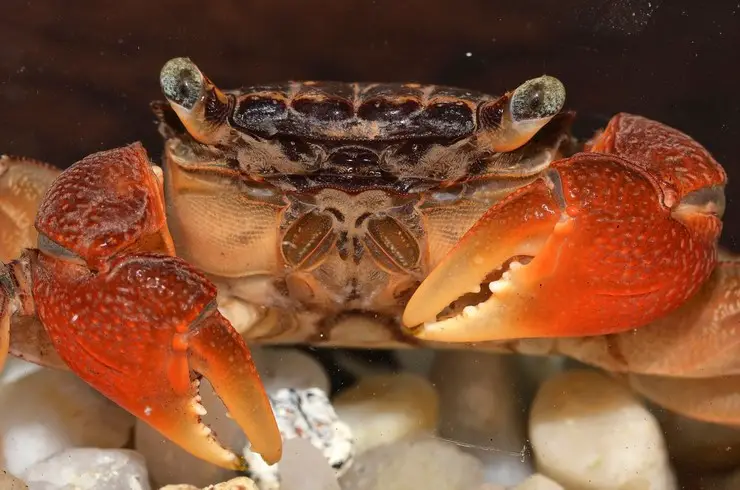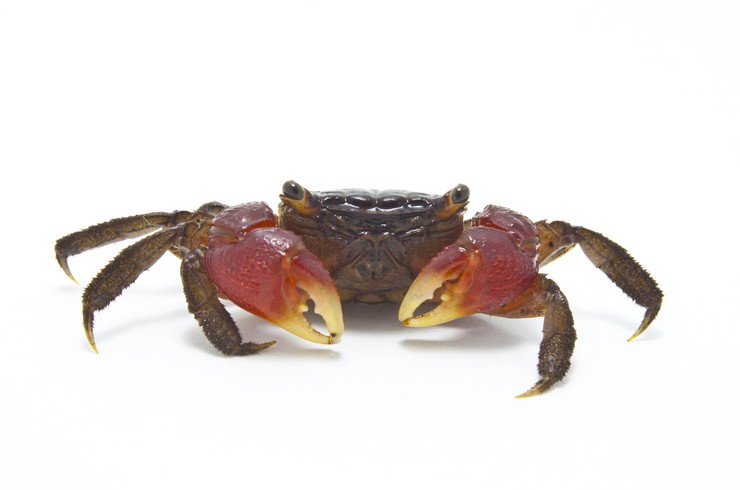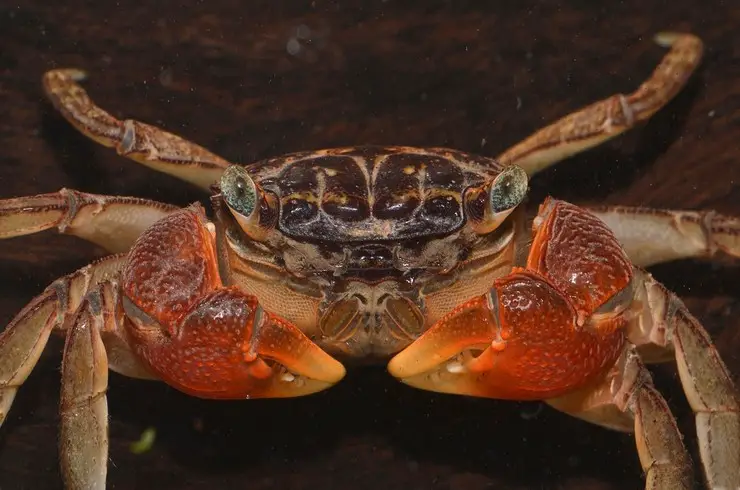The interest in decorative crabs is growing every year. These exotic animals attract attention with beautiful colors, funny behavior, and give a chance to get to know the life of crustaceans better. One of the most commonly sold species is the red mangrove crab. Read about how to properly contain this little bully in our article.
General information
The red mangrove crab (Pseudosesarma moeschii) is a tropical crustacean of the Sesarmidae family. The name directly indicates the main habitat of these animals – mangroves of the countries of Southeast Asia.
The lifestyle of red mangrove crabs is inextricably linked to water, although they still spend most of the time on land. The water in natural habitats is brackish, so this crab cannot be called completely freshwater, although at home it can live in freshwater without any problems.
Watching crabs will give you real pleasure. They love to sit on a dais in their home and observe others. Although in case of danger, they immediately rush into the water and hide in shelters. Red mangrove crabs also love to do landscape design – rearrange the decorations in the aquarium to their liking.
Breeding the crab is difficult due to the presence of the floating larva stage, therefore, individuals caught in nature are supplied to the market.
Appearance
The appearance of the red mangrove crab is typical for all members of the group. The body is rounded, covered on top with a dense shell (carapace). Below is a short bent abdomen – abdomen. The crab has five pairs of walking legs, the front one has turned into an organ of food capture and protection – pincers. Above the front part of the body there are two eyes on movable stalks, and below – the mouth opening with several pairs of jaws.
The size of the shell of the red mangrove crab is small: males grow up to 4-5 cm, and females up to 3 cm. The body color is quite variable, but most often individuals with a dark purple back, red-purple walking legs, and bright red claws are found. Often in crabs, the joints have a different color from the segments of the legs: yellow or orange. Red mangrove crab can pinch a lot, so you need to be careful when handling the animal.
Life expectancy in suitable conditions is about 4 years.
Habitat
The red mangrove crab lives in vast areas of mangrove forests in Southeast Asia. At high tide, their territory is flooded with water, and after low tide on the soil, crabs look for a variety of “snacks” presented by the sea. Ocean water in these territories mixes with the freshwater of rivers, so its salinity is lower.
It is not uncommon to find these vagabonds on numerous beaches, where they crawl in search of food, being excellent “orderlies”.
Care and maintenance
It is necessary to keep red mangrove crabs in the aqua terrarium, a third of which should be occupied by land. It is desirable that one individual has a bottom area of at least 30×30 cm. The water level should not exceed 15 cm. To make access to land, artificial grottoes and piles of stones are used. Coarse sand or pebbles are laid at the bottom of the water part. Underwater and on land, organize more shelters in which animals will hide in case of danger. It is useful to plant more aquatic plants that can tolerate salted water: elodea, hornwort, Indian fern, etc.
The aqua terrarium must necessarily have a tight cover, and it is recommended to close all openings with a net because red mangrove crabs are real experts in the escape. The animal cannot be without water for a long time, therefore it is necessary to find it as early as possible. Crabs are easily caught on a damp cloth left on the floor.
A warm and humid microclimate is very important for the comfortable existence of red mangrove crabs. It is recommended to maintain the water temperature within the range of 22-24 ° С, and the air temperature 26-28 ° С. Air humidity should not fall below 80%. Regular spraying of water on the inner contents of aqua terrariums can help.
A small filter must be installed in the water to keep it clean longer. Small water changes are made once a week (up to 20%). Before adding fresh water to the aquarium, treat it with Tetra Crusta AquaSafe. It will remove compounds that are dangerous to your pets, such as chlorine and heavy metals from the water. Thus, you no longer have to defend water.
Red mangrove crabs can be kept in both freshwaters of sufficient hardness (15-22 dGH) or lightly salted water. Salt is the best used specialized salt, which can be purchased at pet stores.
A very important stage in the life of the red mangrove crab is molting. During it, the invertebrate sheds its old shell and acquires a new one. At first, it remains very soft, which allows the crabs to grow in size. Molting is energy-intensive and stressful for animals. Unfortunately, the main reason for the death of crabs is molting problems. The pluses of molting include the possibility of restoring lost limbs.
After shedding the old cover, crabs are very vulnerable, even their own relatives can pose a danger. The shell remaining after molting should not be thrown out of the aqua terrarium, because crabs are happy to dispose of it by eating it. The frequency of molting depends on the age of the crustaceans: young individuals molt more often than adults.
Compatibility
In nature, red mangrove crabs lead a solitary lifestyle, meeting with females only during the breeding season. Therefore, you should not be afraid that your pet will live alone in the aqua terrarium. This is a comfortable state for him.
If you decide to start a group of crabs, then be prepared for constant collisions with each other. There is no exception for either males or females. The only way to reduce tensions is to keep crabs in spacious aqua terrariums with a large bottom area and numerous hiding places. But even this is not a guarantee of survival. A larger male can always look after an opponent after molting and inflict injuries incompatible with life.
But other species of animals are not at all interested in crabs from a gastronomic point of view, because they are scavengers and not active hunters. Therefore, they can be safely kept with small fish, shrimps, snails. The worst thing that can happen is that crabs pluck the fins of the fish.
Feeding the red mangrove crab
Like most other relatives, red mangrove crabs are omnivorous crustaceans. In nature, they do not disdain any food that gets under their paws: worms, insects, detritus, dried leaves, etc. But still, the basis of their diet should be plant foods: pieces of vegetables, fruits, herbs, and berries.
However, it is dangerous to exclude animal food – it should make up at least 1/3 of the diet. You can feed red mangrove crabs with specialized crustacean feed Tetra Crusta or tablet feed for bottom fish such as Tetra WaferMix.
Crabs feed on land, so don’t throw food into the water. It is best to set aside a small area where your pets will eat.
Reproduction and breeding
Unfortunately, it is not possible to get offspring from the red mangrove crab at home. This is due to the fact that saltwater is necessary for the development of the larvae – the female throws eggs into the sea before hatching. The emerging larvae develop here for 6-8 weeks, after which they turn into full-fledged small crabs and go out on land.
